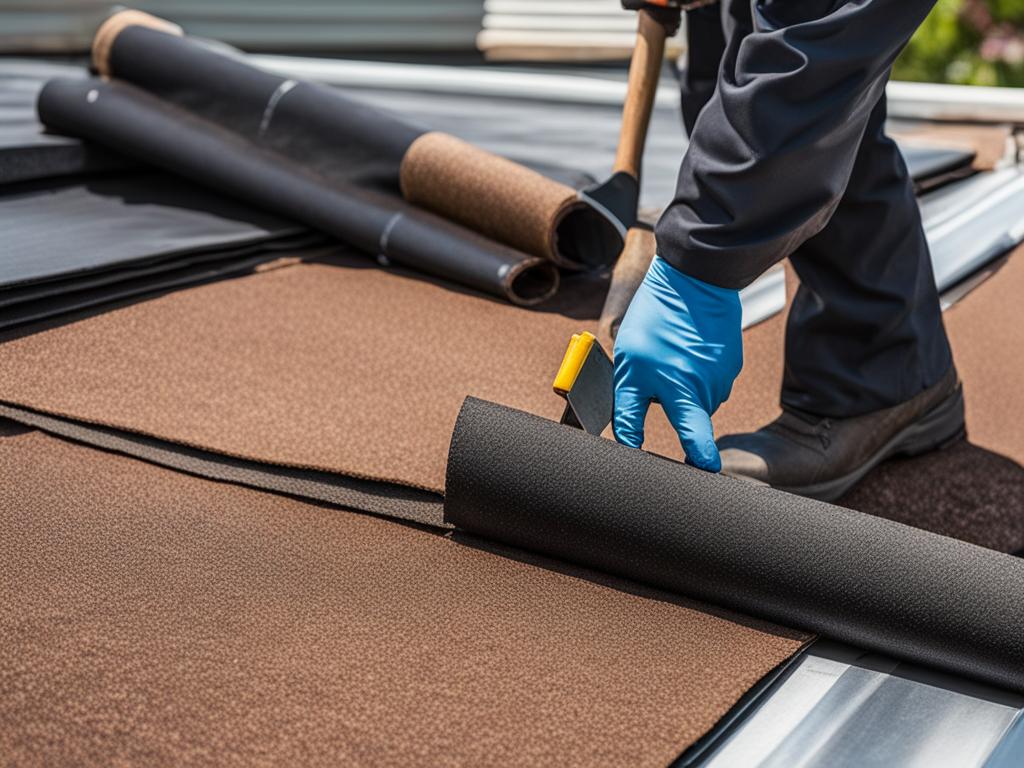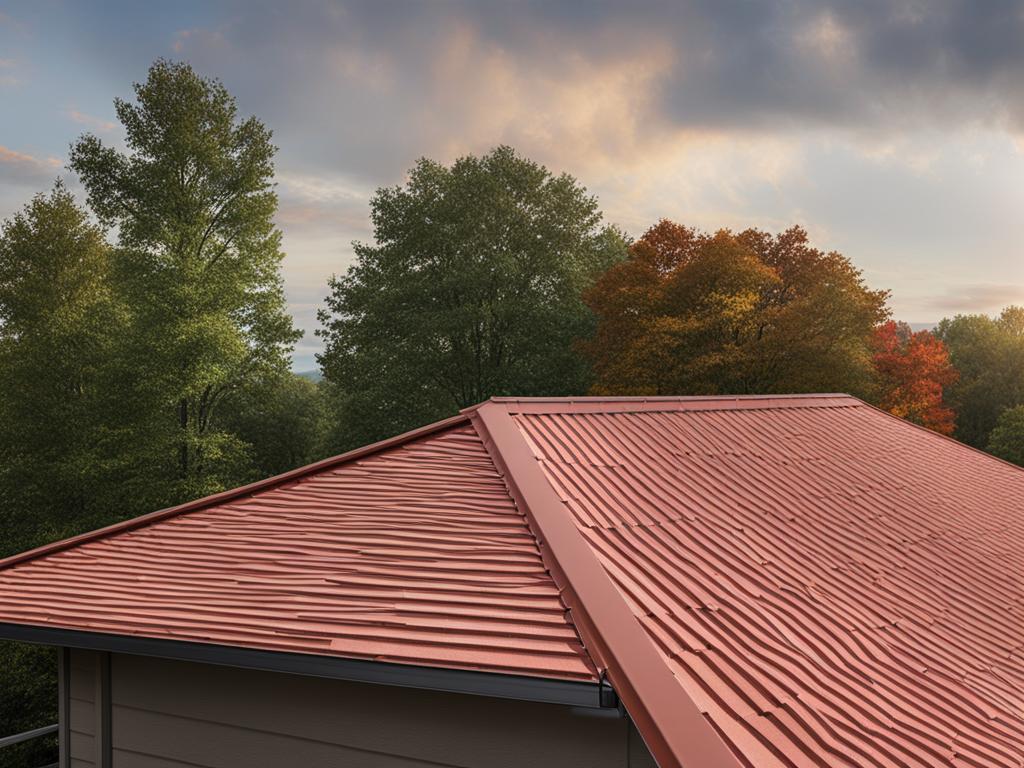The debate on modified bitumen roofing vs. roll roofing has been going on for a while. In this article, we will compare these two roofing materials based on their pros and cons, types, costs, and other factors. Knowing these details will help you make an informed decision when upgrading your roof.
Modified bitumen roofing, also known as bitumen roofing, is a popular choice for residential and commercial roofs. It is composed of asphalt modified with rubber or plastic polymers, which enhance its flexibility and durability. On the other hand, roll roofing is a cost-effective roofing material made from asphalt. It comes in large rolls and is easy to install, making it a popular choice for DIY enthusiasts.
In the following sections, we will delve deeper into the specifics of modified bitumen roofing and roll roofing, highlighting their pros and cons, installation methods, lifespan, and suitability for different climates.
Key Takeaways:
- Modified bitumen roofing and roll roofing are two popular options for roofing materials.
- Modified bitumen roofing offers enhanced durability and flexibility with a variety of colors and textures to choose from.
- Roll roofing is an affordable option that is easy to install, making it suitable for mild climates and roofs with a low pitch.
- Consider factors such as cost, durability, weather resistance, and specific roof type when choosing between modified bitumen roofing and roll roofing.
- Consult with roofing experts to determine the best option for your property.
What is Modified Bitumen Roofing?
Modified bitumen roofing is a type of roofing material that is composed of asphalt modified with rubber or plastic polymers. This modification enhances the flexibility and durability of the asphalt, making it less prone to cracking and weathering. Modified bitumen roofing is commonly used for commercial and residential buildings due to its numerous benefits.
Types of Modified Bitumen Roofing
There are two main types of modified bitumen roofing:
- SBS Bitumen: SBS (styrene-butadiene-styrene) modified bitumen roofing is known for its high flexibility and superior performance in extreme weather conditions. This type of bitumen roofing can withstand temperature fluctuations, making it ideal for areas with harsh climates such as regions prone to freezing temperatures or intense heat.
- APP Bitumen: APP (atactic polypropylene) modified bitumen roofing is popular for its resistance to UV rays. This type of bitumen roofing is more resilient against the damaging effects of sunlight, making it a suitable choice for buildings located in areas with strong sun exposure.
Both types of modified bitumen roofing offer excellent durability and weather resistance, making them reliable options for a wide range of roofing applications.
Modified Bitumen Installation Methods
Modified bitumen roofing can be installed using several methods. The choice of installation method depends on factors such as the specific roofing project and the preferences of the installer or contractor. Some common modified bitumen installation methods include:
- Welding/Torching: This installation method involves heating the modified bitumen sheets with a torch to create a secure bond.
- Cold Application: Cold application refers to the use of adhesives or self-adhesive sheets to bond the modified bitumen to the roof deck without the need for heat.
- Self-Adhesion: Certain modified bitumen membranes come with a self-adhesive backing, eliminating the need for additional adhesives or torching during installation. This method is often preferred for its simplicity and ease of use.
Each installation method has its advantages and considerations, and it is essential to consult with roofing professionals to determine the most suitable method for your specific roofing project.
| Modified Bitumen Roofing | Advantages |
|---|---|
| SBS Bitumen | High flexibility, suitable for extreme weather conditions |
| APP Bitumen | Resistance to UV rays |
| All Types | Durability, weather resistance |
Modified bitumen roofing is a versatile and reliable choice for both commercial and residential buildings. Its flexibility, durability, and resistance to weathering make it an excellent option for various climates and roofing needs. The different installation methods provide flexibility for installation preferences, ensuring a secure and long-lasting roofing system.
What is Roll Roofing?
Roll roofing is a popular roofing material composed of asphalt. It is similar to asphalt shingles, but it differentiates itself by coming in large rolls that are typically 36 inches wide and 33 feet long. This format allows for efficient installation and coverage of larger areas. Roll roofing is available in two main types: organic and fiberglass.
Organic roll roofing is made from recycled, asphalt-saturated felt paper. This type of roll roofing is environmentally friendly and offers good durability and weather resistance. It is suitable for various climates and can be a cost-effective option for homeowners.
Fiberglass roll roofing features a fiberglass mat base coated with asphalt. This type of roll roofing delivers excellent strength, flexibility, and resistance to cracking. Additionally, fiberglass roll roofing is known for its fire resistance properties, making it a safe and reliable choice.
Roll roofing can be installed by rolling out the material and securing it to the roof deck with nails, screws, or adhesive. Its installation process is relatively straightforward, making it suitable for both DIY enthusiasts and professional contractors. However, it’s essential to ensure proper installation techniques to maximize its performance and longevity.
Whether you opt for asphalt roll roofing, organic roll roofing, or fiberglass roll roofing, you can benefit from its cost-effectiveness, durability, and easy installation. Consider consulting with a roofing professional to determine the best roll roofing option for your specific needs and budget.
| Type | Description |
|---|---|
| Organic Roll Roofing | Made from recycled, asphalt-saturated felt paper. Offers good durability and weather resistance. |
| Fiberglass Roll Roofing | Features a fiberglass mat base coated with asphalt. Provides excellent strength, flexibility, and fire resistance. |

Pros of Modified Bitumen Roofing
Modified bitumen roofing offers several advantages that make it a popular choice for both residential and commercial buildings. Here are some key benefits of opting for modified bitumen roofing:
- Durability: Modified bitumen roofing is highly durable and can withstand the test of time. With proper installation and maintenance, it can last up to 20 years, providing long-lasting protection for your property.
- Flexibility: One of the standout features of modified bitumen roofing is its flexibility. It can expand and contract with changing temperatures without cracking or suffering from thermal shock, ensuring its integrity even in extreme weather conditions.
- Variety of Colors: Unlike traditional roofing materials, modified bitumen roofing comes in a wide range of colors and textures. This allows for creative design options, making it possible to match the roof with the overall aesthetic of the building.
- Energy Efficiency: Modified bitumen roofing has excellent energy-saving properties. Its reflective surface helps to minimize heat buildup by reflecting sunlight. This can result in lower energy consumption and reduced cooling costs.
- Hail Resistance: Modified bitumen roofing is known for its exceptional hail resistance. It can withstand the impact of hailstones without sustaining significant damage. This feature adds an extra layer of protection to your roof.
- Weather Resistance: Whether you live in a rainy, snowy, or windy area, modified bitumen roofing is up to the task. Its weather-resistant properties make it highly suitable for regions with variable climates, ensuring reliable performance even in challenging conditions.
- Easy Repairs: In the event of damage, repairs to modified bitumen roofing are relatively easy to perform. The same material used for installation can be used for repairs, simplifying the process and minimizing costs.
Expert Quote:
“Modified bitumen roofing offers an appealing combination of durability, flexibility, and energy efficiency. Its wide array of colors and textures allows for creative customization, making it a popular choice among architects and homeowners.” – Jane Smith, Roofing Expert
As you can see, modified bitumen roofing has numerous advantages that make it an attractive option for those in need of a reliable and aesthetically pleasing roof. Its durability, flexibility, variety of colors, energy efficiency, hail resistance, weather resistance, and easy repair process contribute to its popularity in the roofing industry.
Pros of Roll Roofing
Roll roofing offers a range of benefits that make it a popular choice for many homeowners. Here are some of the pros of using roll roofing:
- Affordability: Roll roofing is known for its budget-friendliness, making it an excellent option for those on a tight budget.
- Easy Installation: Installing roll roofing is a straightforward process that requires minimal tools and equipment. It is a suitable option for those who prefer DIY installations.
- Lightweight: Roll roofing is lightweight compared to other roofing materials. This makes it an ideal choice for buildings that cannot support heavier roofing materials without compromising structural integrity.
- Suitable for Mild Climates: Roll roofing performs well in mild climates. It is designed to protect your roof and withstand heat, humidity, and other weather elements typical of such regions.
- Quick Installation: Roll roofing can be quickly installed, saving both time and labor costs. This is especially beneficial for projects with tight timelines.
When considering your roofing options, the pros of roll roofing make it an appealing and practical choice for many homeowners.

Cons of Modified Bitumen Roofing
While modified bitumen roofing offers many benefits, it is important to consider the drawbacks associated with this roofing material.
Higher Initial Cost
One of the cons of modified bitumen roofing is its higher initial cost compared to other types of roofing materials. This can be a deterrent for budget-conscious homeowners or property owners.
Regular Maintenance Required
In order to maximize the lifespan of a modified bitumen roof, regular maintenance is necessary. This includes periodic inspections, cleaning, and repairs. Failure to perform regular maintenance can lead to premature deterioration of the roofing system.
Eco-Friendliness Concerns
There are some concerns regarding the eco-friendliness of modified bitumen roofing. The use of chemicals in its composition raises questions about its impact on the environment. Some individuals may prefer more sustainable roofing options.
In conclusion, while modified bitumen roofing has its advantages, such as durability and flexibility, there are cons to consider. These include a higher initial cost, regular maintenance requirements, and concerns about eco-friendliness. It is important to carefully weigh these factors and consult with roofing experts before making a decision.
Cons of Roll Roofing
While roll roofing can be a suitable option for certain situations, it’s important to consider its disadvantages:
- Shorter lifespan: Roll roofing has a shorter lifespan compared to other roofing materials, typically lasting between 8 and 15 years.
- Vulnerability to weathering: Roll roofing is more prone to weathering, which can lead to premature deterioration and the need for frequent repairs.
- Unsuitable for high wind areas: Due to its lightweight nature and the way it is installed, roll roofing is not recommended for areas with high winds as it may become easily damaged.
- Limited suitability for certain roof types: Roll roofing is best suited for flat or slightly pitched roofs. It may not be suitable for roofs with complex angles or curves.
Being aware of these limitations will help you make an informed decision when choosing the right roofing material for your specific needs
Comparison of Lifespan and Wind Resistance
| Lifespan | Wind Resistance | |
|---|---|---|
| Modified Bitumen Roofing | 20+ years | High |
| Roll Roofing | 8-15 years | Low |
Conclusion
After comparing the pros and cons of modified bitumen roofing and roll roofing, it is clear that modified bitumen offers more advantages. Not only is it a cost-effective option in the long run due to its durability and performance, but it is also suitable for various weather conditions, providing energy efficiency benefits. On the other hand, roll roofing can be a budget-friendly choice for mild climates and specific roof types.
The final decision between modified bitumen and roll roofing depends on several factors, including location, budget, and specific needs. It is always recommended to consult with roofing experts to determine the best option for your property. They can assess the specific requirements of your project and provide you with valuable insights and tailored solutions.
In conclusion, modified bitumen roofing is a reliable and durable choice, offering long-term cost-effectiveness and weather resistance. However, for those looking for a more affordable option suited for mild climates and specific roof types, roll roofing can be a suitable alternative. Consider your location-based considerations, budget constraints, and desired durability when making your decision.
FAQ
What is modified bitumen roofing?
Modified bitumen roofing is composed of asphalt modified with rubber or plastic polymers, which enhances its flexibility and durability.
What are the types of modified bitumen roofing?
The two types of modified bitumen roofing are SBS (styrene-butadiene-styrene) and APP (atactic polypropylene).
How is modified bitumen roofing installed?
Modified bitumen roofing can be installed using methods like welding/torching, cold application, or self-adhesion.
What is roll roofing?
Roll roofing is made from asphalt and comes in large rolls. It is available in two types: organic and fiberglass.
How is roll roofing installed?
Roll roofing is installed by rolling out the material and securing it to the roof deck with nails, screws, or adhesive.
What are the pros of modified bitumen roofing?
Modified bitumen roofing is durable, flexible, comes in a variety of colors, offers energy efficiency benefits, and is resistant to hail and weather damage.
What are the pros of roll roofing?
Roll roofing is affordable, easy to install, lightweight, and suitable for buildings with low pitch roofs.
What are the cons of modified bitumen roofing?
The cons of modified bitumen roofing include a higher initial cost, the need for regular maintenance, and potential concerns about its eco-friendliness.
What are the cons of roll roofing?
The cons of roll roofing include a shorter lifespan, vulnerability to weathering, unsuitability for high wind areas, and limited suitability for certain roof types.
Which roofing material is more cost-effective?
Both modified bitumen roofing and roll roofing have cost advantages depending on factors like initial cost, durability, and specific needs.
